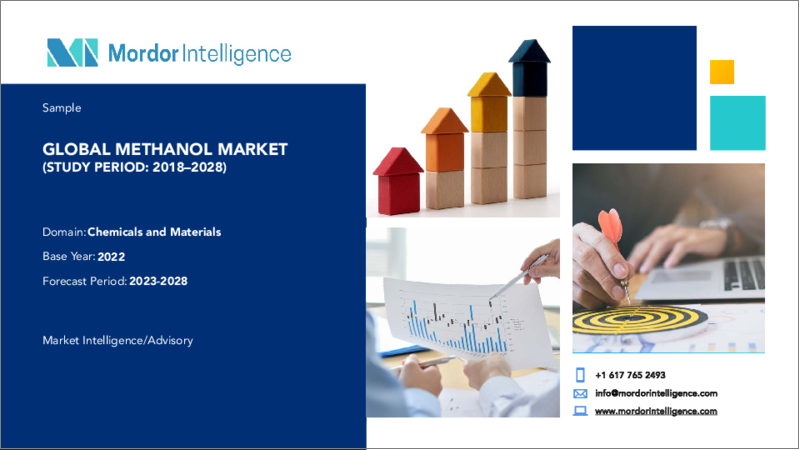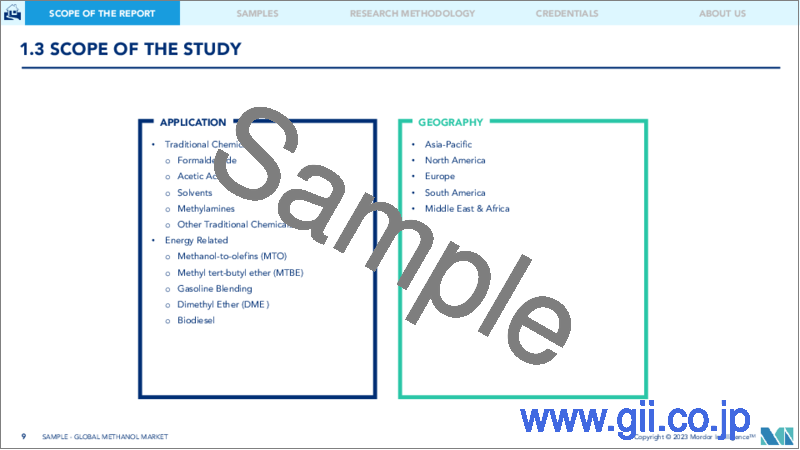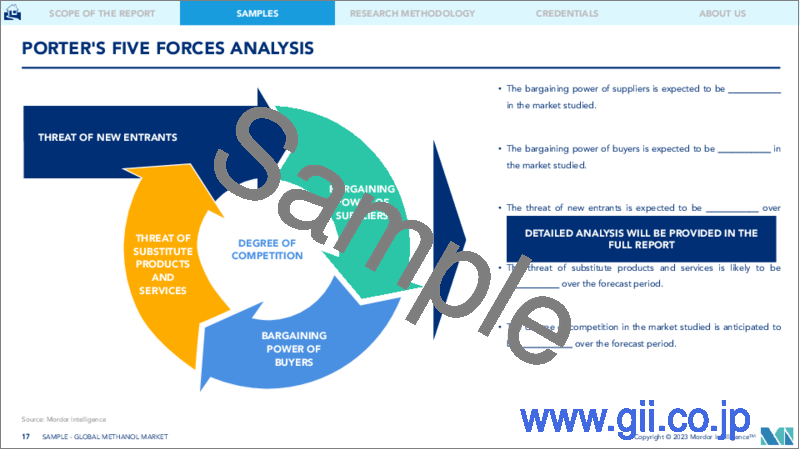|
|
市場調査レポート
商品コード
1197581
メタノール市場- 成長、動向、予測(2023年-2028年)Methanol Market - Growth, Trends, and Forecast (2023 - 2028) |
||||||
|
● お客様のご希望に応じて、既存データの加工や未掲載情報(例:国別セグメント)の追加などの対応が可能です。 詳細はお問い合わせください。 |
|||||||
| メタノール市場- 成長、動向、予測(2023年-2028年) |
|
出版日: 2023年01月23日
発行: Mordor Intelligence
ページ情報: 英文 180 Pages
納期: 2~3営業日
|
- 全表示
- 概要
- 目次
メタノール市場は、今年末までに92,700キロトンを超えると推定されます。
予測期間中は3.5%を超えるCAGRで推移すると予測されています。
COVID-19のパンデミックは、2020年と2021年の前半に政府の禁止令や制限を課したため産業活動を大幅に縮小させ、メタノール市場の成長を制限しました。化学業界は、原料供給の不足、労働時間/財務体質の制限、需要の減少、財務の制約により麻痺しました。しかし、2021年半ばにパンデミックが後退して以来、化学・石油化学業界は回復基調にあります。エンドユーザー部門における化学品の急激な需要増が引き続き圧力となっており、メタノール市場の成長に寄与することが期待されます。
主なハイライト
- 中期的には、中国、米国、その他のアジア太平洋諸国における石油化学部門の拡大、およびメタノールベースの燃料需要の増加が、本市場の成長を増大させる主要な原動力となっています。さらに、MTOを使用したオレフィン製造におけるメタノール利用の拡大が、化学産業におけるオフテイクの増加を促進しています。
- 一方、メタノールよりもエタノール燃料やバイオエタノールが好まれ、それに伴う健康被害が予測期間中の対象産業の成長を抑制すると予想されます。
- しかしながら、新規および拡張中の燃料用途におけるメタノールの使用と、再生可能なメタノールに対する産業界の傾斜の高まりは、近い将来、同市場に有利な成長機会をもたらすと思われます。
- アジア太平洋地域は、メタノールの最大市場として浮上しました。予測期間中、最も高いCAGRで推移すると予想されています。アジア太平洋地域の優位性は、中国、日本、その他の東南アジア諸国におけるメタノール需要の高さ、化学分野およびその他の用途分野の拡大によるものです。
メタノール市場の動向
エネルギー関連用途が市場を独占
- エネルギー関連用途でのメタノール使用量は、過去数年で大幅に増加しました。メタノールはメタノール-オレフィン(MTO)変換反応に広く使用されており、石炭・天然ガスなどの非石油資源から基礎石油化学製品(エテン、プロペン、ブテン、ブタジエンなど)を製造する機会を提供しています。
- メタノールは、ガソリンに添加し酸素濃度を高めてオクタン価を向上させるメチルターシャリーブチルエーテル(MTBE)の前駆体です。MTBEはガソリンを完全燃焼させるため、一酸化炭素などの有害ガスや自動車からの排ガスを減らし、大気汚染を抑制します。
- メタノールは、世界中の多くのガソリン市場で、ガソリンの供給量を増やすために使用され、成功を収めています。メタノールをガソリン供給に加えることで、非石油系の代替エネルギーと、クリーンで燃焼性の高いハイオク燃料を提供することができるのです。Methanol Instituteによると、他のアルコールとは異なり、メタノールのガソリンへの混合は、政府の補助金や燃料混合義務なしに経済的に行われてきました。
- メタノールはジメチルエーテルの製造にも使用され、着火性が良く、セタン価が高いことから、燃料の代替品として重要な役割を担っています。ディーゼルエンジンでのDMEの燃焼は非常にクリーンで、煤も出ないです。DMEは、従来のディーゼル燃料の代替としてディーゼルエンジンに使用することができます。
- メタノールは、原油由来のディーゼル燃料に代わる再生可能燃料として注目されているバイオディーゼルの製造に不可欠な出発原料です。メタノールは、トリグリセリドとの反応性に優れ、アルカリ性に溶けやすいため、エタノールよりもトランスエステル化反応に適しています。
- バイオディーゼルは、エネルギー安全保障を向上させ、二酸化炭素排出量の削減につながるクリーンな燃焼燃料です。また、引火点が高く(最低100℃)、軽油と任意の割合で混合することができ、自動車への燃料供給時に両燃料を混合することも可能です。バイオディーゼルの環境性能は、パンデミック時の2020年を除き、歴代のバイオディーゼル生産量の増加傾向に拍車をかけた。BP Statistical Review of World Energy, 2022によると、2020年に若干の減少を示した後、2021年のバイオディーゼル生産量は回復し、734千バレル/日(パンデミック前より高い水準)に達しています。生産量の増加傾向は、予測期間中にバイオディーゼル生産におけるメタノール消費量の割合を増加させると考えられます。
- 上記の要因を考慮すると、エネルギー関連用途でのメタノールの使用および需要は予測期間中に拡大するものと思われます。
アジア太平洋地域が市場を独占
- アジア太平洋地域は、大きな市場シェアで世界市場を独占しています。予測期間中もその優位性を維持すると予測されます。中国だけで、世界のメタノールの60%以上を生産・消費しており、中国が世界のリーダーとなっています。中国河南省安陽市では、回収した二酸化炭素と水素ガスからメタノールを製造する世界初の商業規模施設となる「最先端」の二酸化炭素メタノール化プラントが生産を開始しました。
- メタノール研究所によると、中国ではメタノールは700万台の自動車に使用されており、中国の燃料プールの5%以上に貢献しています。メタノールは、石炭を主原料とする発電方法であっても、従来のガソリン自動車に比べて二酸化炭素の排出量が26%少なくなります。中国の工業情報化省は「メタノール自動車の普及を拡大する」計画を発表し、「グリーンメタノール+メタノール自動車」構想を研究しています。
- インドでは、NITI Aaayogが2030年までに原油輸入の10%をメタノールだけで代替する戦略を立案しました。これには約30MTのメタノールが必要です。メタノールとDMEは、ガソリンやディーゼルよりもかなり安価で、インドは2030年までに燃料費を30%削減できると見込んでいます。
- 日本には、川崎重工、ヤマハ、トヨタ、ホンダ、日産、スズキなどの大手自動車メーカーがあり、メタノールを燃料とする車の開発を計画しています。日本の国家エネルギー戦略では、2030年までにガソリン依存度を50%から40%に減らし、エネルギー効率を30%向上させ、輸送用燃料の20%をメタノールなどの代替燃料で置き換えることを目標としており、市場調査の需要が高まっています。
- シンガポールは、船舶用燃料としてのメタノールの生産と流通のための世界のインフラを確立するために、最も新しく参加した国です。シンガポールは、海運業における世界最大のバンカリングセンターとして既に認知されていますが、海運業と燃料業界の協力により、東南アジアで最初のグリーンeメタノール施設となることが予定されています。
- 上記のすべての要因が、予測期間中にアジア太平洋地域のメタノール市場の成長を促進するものと思われます。
メタノール市場の競合他社分析
メタノール市場は断片的であり、トップ企業が個別に市場需要に影響を与えるほどのシェアを保有しているわけではありません。市場の主要プレイヤー(順不同)には、SABIC、Proman、Ningxia Baofeng Energy Group、Methanex Corporation、ZPCIRなどがいます。
その他の特典
- エクセル形式の市場予測(ME)シート
- アナリストによる3ヶ月間のサポート
目次
第1章 イントロダクション
- 調査の前提条件
- 調査範囲
第2章 調査手法
第3章 エグゼクティブサマリー
第4章 市場力学
- 促進要因
- 中国、米国、その他アジア太平洋諸国における石油化学部門の拡大
- メタノール系燃料の需要増加
- MTOを使用したオレフィン製造におけるメタノール利用の増加
- 抑制要因
- メタノールと比較して、エタノール燃料やバイオエタノールの使用量が多いこと
- 健康への有害な影響
- 産業バリューチェーン分析
- ポーターのファイブフォース分析
- 供給企業の交渉力
- 買い手の交渉力
- 新規参入業者の脅威
- 代替品の脅威
- 競合の度合い
- 世界の主要原料別メタノール生産能力
- 技術スナップショット
- 貿易分析
- 価格動向
第5章 市場セグメンテーション(市場規模:数量ベース)
- 用途別
- 従来化学品
- ホルムアルデヒド
- 酢酸
- 溶媒
- メチルアミン
- その他伝統的化学品
- エネルギー関連
- メタノール-オレフィン(MTO)
- メチルtert-ブチルエーテル(MTBE)
- ガソリン混合
- ジメチルエーテル(DME)
- バイオディーゼル
- 従来化学品
- 地域別情報
- アジア太平洋地域
- 中国
- インド
- 日本
- 韓国
- その他アジア太平洋地域
- 北米
- 米国
- カナダ
- メキシコ
- 欧州
- ドイツ
- 英国
- イタリア
- フランス
- その他欧州
- 南米
- ブラジル
- アルゼンチン
- その他の南米地域
- 中東地域
- サウジアラビア
- 南アフリカ共和国
- その他の中東地域
- アジア太平洋地域
第6章 競合情勢
- M&A、ジョイントベンチャー、提携、契約
- 市場シェア(%)分析
- リーディングプレイヤーが採用する戦略
- 企業プロファイル
- Atlantic Methanol
- BASF SE
- Celanese Corporation
- Coogee
- Enerkem
- Eni SPA
- Gujarat State Fertilizers & Chemicals Limited(GSFC)
- Ineos
- Kingboard Holdings Limited
- Lyondellbasell Industries Holdings BV
- Methanex Corporation
- Mitsubishi Gas Chemical Company Inc.
- Mitsui & Co. Ltd
- Ningxia Baofeng Energy Group Co. Ltd
- OCI NV
- Petroliam Nasional Berhad
- Proman
- Sabic
- ZPCIR
第7章 市場機会および将来動向
- 新規および拡大する燃料用途におけるメタノール利用
- 再生可能なメタノールへの高まる動向
The methanol market is estimated to reach over 92,700 kilo tons by the end of the current year. It is projected to register a CAGR of over 3.5% during the forecast period.
The COVID-19 pandemic drastically curtailed industrial activities due to imposed government bans and restrictions in 2020 and the first half of 2021, limiting the growth of the methanol market. The chemical industry was paralyzed due to scarce raw material supply, limited working hours/labor strength, reduced demand, and constrained financials. However, the chemical and petrochemical industries have been on track for recovery since the retraction of the pandemic in mid-2021. The exponential rise in demand for chemicals in end-user sectors continues to exert pressure, which is expected to contribute to the growth of the methanol market.
Key Highlights
- Over the medium term, the expanding petrochemical sector in China, the United States, and other Asia-Pacific countries and the rising demand for methanol-based fuels are the major driving factors augmenting the growth of the market studied. Furthermore, the growing utilization of methanol in producing olefins using MTO propels increased offtakes in the chemical industries.
- On the other side, the higher preference for ethanol fuel or bioethanol over methanol and the health hazardous impacts associated with it are anticipated to restrain the growth of the target industry over the forecast period.
- Nevertheless, the use of methanol in new and expanding fuel applications and the growing industrial inclination toward renewable methanol are likely to create lucrative growth opportunities for the market soon.
- The Asia-Pacific emerged as the largest market for methanol. It is expected to witness the highest CAGR during the forecast period. The dominance of the Asia-Pacific is attributed to the high demand for methanol in China, Japan, and other Southeast Asian countries, expanding chemical and other application sectors.
Methanol Market Trends
Energy-related Applications to Dominate the Market
- The use of methanol in energy-related applications increased significantly in the past few years. Methanol is widely used in methanol-to-olefins (MTO) transformation reactions, which provides a chance to produce basic petrochemicals (such as ethene, propene, butene, and butadiene) from non-oil resources like coal and natural gas.
- Methanol is a precursor for producing methyl tertiary-butyl ether (MTBE), which is added to gasoline to enhance the octane number by increasing the oxygen content. MTBE leads to the complete combustion of gasoline and, thus, lowers the exhaust of harmful gases, like carbon monoxide, and other emissions from vehicles, reducing air pollution.
- Methanol has been successfully used to extend gasoline supplies in many gasoline markets worldwide. Adding methanol to the gasoline supply provides non-petroleum alternative energy and a clean-burning, high-octane fuel. According to the Methanol Institute, unlike other alcohols, methanol blending in gasoline has been economical without government subsidies or fuel-blending mandates.
- Methanol is also used to produce dimethyl ether, which registers significant usage as a fuel substitute, due to its good ignition quality and high cetane number. DME in diesel engines burns very cleanly with no soot. It can be used in diesel engines as a substitute for conventional diesel fuel.
- Methanol is a crucial starting material for the production of biodiesel, which is viewed as an alternative renewable fuel for crude oil-derived diesel. Methanol is preferred over ethanol for the transesterification reaction due to its superior reactivity with triglycerides and high alkaline dissolution properties.
- Biodiesel is a clean burning fuel that increases energy security and leads to a lower carbon footprint. It exhibits a higher flash point (100°C minimum) and can be blended with diesel fuel at any proportion; both fuels can be mixed during the fuel supply to vehicles. The environmental benefits of biodiesel had spurred the continued increase in biodiesel production in the historical years, except for 2020, when the pandemic was at large. According to the BP Statistical Review of World Energy, 2022, the production of biodiesel in 2021 recovered, reaching 734 thousand barrels per day (higher than pre-pandemic levels) after showing a slight decrement in 2020. The increasing production trend is likely to increase the share of methanol consumption in biodiesel production during the forecast period.
- Considering all the abovementioned factors, the use and demand of methanol for energy-related applications are expected to grow in the forecast period.
Asia-Pacific Region to Dominate the Market
- The Asia-Pacific dominated the worldwide market with a significant market share. It is projected to maintain its dominance during the forecast period. China alone is the largest producer and consumer of over 60% of the world's methanol, making the country the worldwide leader. In Anyang, Henan Province, China, a 'cutting-edge' carbon dioxide-to-methanol plant has begun production, becoming the world's first commercial-scale facility to manufacture methanol from captured waste carbon dioxide and hydrogen gases.
- According to the Methanol Institute, methanol powers up to 7 million automobiles in China, contributing to more than 5% of the country's fuel pool. Methanol emits 26% less carbon dioxide than conventional gasoline-powered automobiles, even when generated primarily using coal-based techniques. China's Ministry of Industry and Information Technology announced plans to "increase the popularity of methanol automobiles" and study the 'green methanol + methanol cars' concept.
- In India, NITI Aaayog has designed a strategy to replace 10% of crude imports with methanol alone by 2030. This takes about 30 MT of methanol. Methanol and DME are significantly less expensive than petrol and diesel; India expects to lower its fuel expense by 30% by 2030.
- Japan is home to some major automotive producers, including Kawasaki, Yamaha, Toyota, Honda, Nissan, and Suzuki, who are planning to develop vehicles that use methanol as fuel. The National Energy Strategy of Japan focuses on reducing petrol dependency from 50% to 40% by 2030, improving energy efficiency by 30%, and replacing 20% of transport fuel with an alternative fuel, such as methanol, enhancing the demand for the market studied.
- Singapore is the most recent country to join the ongoing efforts to establish a worldwide infrastructure for producing and distributing methanol as a marine fuel. Singapore, which is already recognized as the world's largest bunkering center for the shipping sector, is set to become the first green e-methanol facility in Southeast Asia, a collaboration between the shipping and fuel industries.
- All abovementioned factors are likely to fuel the growth of the methanol market in the Asia-Pacific over the forecast period.
Methanol Market Competitor Analysis
The methanol market is fragmented, with top players holding insignificant shares to affect market demand individually. Some major players in the market (in no particular order) include SABIC, Proman, Ningxia Baofeng Energy Group Co. Ltd, Methanex Corporation, and ZPCIR.
Additional Benefits:
- The market estimate (ME) sheet in Excel format
- 3 months of analyst support
TABLE OF CONTENTS
1 INTRODUCTION
- 1.1 Study Assumptions
- 1.2 Scope of the Study
2 RESEARCH METHODOLOGY
3 EXECUTIVE SUMMARY
4 MARKET DYNAMICS
- 4.1 Drivers
- 4.1.1 Expanding Petrochemical Sector in China, the United States, and Other Asia-Pacific Countries
- 4.1.2 Rising Demand for Methanol-based Fuel
- 4.1.3 Increasing Utilization of Methanol in the Production of Olefins Using MTO
- 4.2 Restraints
- 4.2.1 Usage of Ethanol Fuel or Bioethanol in Comparison to Methanol
- 4.2.2 Hazardous Impacts on Health
- 4.3 Industry Value Chain Analysis
- 4.4 Porter's Five Forces Analysis
- 4.4.1 Bargaining Power of Suppliers
- 4.4.2 Bargaining Power of Buyers
- 4.4.3 Threat of New Entrants
- 4.4.4 Threat of Substitute Products and Services
- 4.4.5 Degree of Competition
- 4.5 Global Methanol Production Capacity by Key Feedstock
- 4.6 Technological Snapshot
- 4.7 Trade Analysis
- 4.8 Price Trends
5 MARKET SEGMENTATION (Market Size in Volume)
- 5.1 By Application
- 5.1.1 Traditional Chemical
- 5.1.1.1 Formaldehyde
- 5.1.1.2 Acetic Acid
- 5.1.1.3 Solvent
- 5.1.1.4 Methylamine
- 5.1.1.5 Other Traditional Chemicals
- 5.1.2 Energy Related
- 5.1.2.1 Methanol-to-olefin (MTO)
- 5.1.2.2 Methyl Tert-butyl Ether (MTBE)
- 5.1.2.3 Gasoline Blending
- 5.1.2.4 Dimethyl Ether (DME)
- 5.1.2.5 Biodiesel
- 5.1.1 Traditional Chemical
- 5.2 By Geography
- 5.2.1 Asia-Pacific
- 5.2.1.1 China
- 5.2.1.2 India
- 5.2.1.3 Japan
- 5.2.1.4 South Korea
- 5.2.1.5 Rest of Asia-Pacific
- 5.2.2 North America
- 5.2.2.1 United States
- 5.2.2.2 Canada
- 5.2.2.3 Mexico
- 5.2.3 Europe
- 5.2.3.1 Germany
- 5.2.3.2 United Kingdom
- 5.2.3.3 Italy
- 5.2.3.4 France
- 5.2.3.5 Rest of Europe
- 5.2.4 South America
- 5.2.4.1 Brazil
- 5.2.4.2 Argentina
- 5.2.4.3 Rest of South America
- 5.2.5 Middle East
- 5.2.5.1 Saudi Arabia
- 5.2.5.2 South Africa
- 5.2.5.3 Rest of Middle East
- 5.2.1 Asia-Pacific
6 COMPETITIVE LANDSCAPE
- 6.1 Mergers and Acquisitions, Joint Ventures, Collaborations, and Agreements
- 6.2 Market Share (%) Analysis
- 6.3 Strategies Adopted by Leading Players
- 6.4 Company Profiles
- 6.4.1 Atlantic Methanol
- 6.4.2 BASF SE
- 6.4.3 Celanese Corporation
- 6.4.4 Coogee
- 6.4.5 Enerkem
- 6.4.6 Eni SPA
- 6.4.7 Gujarat State Fertilizers & Chemicals Limited (GSFC)
- 6.4.8 Ineos
- 6.4.9 Kingboard Holdings Limited
- 6.4.10 Lyondellbasell Industries Holdings BV
- 6.4.11 Methanex Corporation
- 6.4.12 Mitsubishi Gas Chemical Company Inc.
- 6.4.13 Mitsui & Co. Ltd
- 6.4.14 Ningxia Baofeng Energy Group Co. Ltd
- 6.4.15 OCI NV
- 6.4.16 Petroliam Nasional Berhad
- 6.4.17 Proman
- 6.4.18 Sabic
- 6.4.19 ZPCIR
7 MARKET OPPORTUNITIES AND FUTURE TRENDS
- 7.1 Use of Methanol in New and Expanding Fuel Applications
- 7.2 Growing Trends Toward Renewable Methanol




